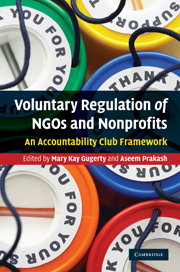Book contents
- Frontmatter
- Contents
- List of figures
- List of tables
- Notes on contributors
- Preface
- The club framework
- Part I Club emergence
- 2 Filling the gaps in nonprofit accountability: applying the club perspective in the US legal system
- 3 Trends and patterns in third-party accreditation clubs
- 4 Self-regulation at the state level: nonprofit membership associations and club emergence
- Part II Club sponsorship and club design
- Part III Club design and effectiveness
- Future research and conclusions
- Index
- References
2 - Filling the gaps in nonprofit accountability: applying the club perspective in the US legal system
from Part I - Club emergence
Published online by Cambridge University Press: 10 November 2010
- Frontmatter
- Contents
- List of figures
- List of tables
- Notes on contributors
- Preface
- The club framework
- Part I Club emergence
- 2 Filling the gaps in nonprofit accountability: applying the club perspective in the US legal system
- 3 Trends and patterns in third-party accreditation clubs
- 4 Self-regulation at the state level: nonprofit membership associations and club emergence
- Part II Club sponsorship and club design
- Part III Club design and effectiveness
- Future research and conclusions
- Index
- References
Summary
Clubs hold significant promise for improving nonprofit accountability if they are consciously designed to complement principals' existing enforcement systems. Although there are legal routes for regulators, funders, and other principals to encourage and enforce financial and organizational accountability, they will be chronically insufficient to educate nonprofit leaders and to provide them with incentives for compliance. Clubs can be designed to backstop and reinforce these baseline enforcement mechanisms. The challenge for clubs, however, is to strike the right balance between imposing meaningful standards and swords in light of other enforcement activity and remaining affordable. This chapter will explore whether and how clubs can help to fill these important gaps and, thereby, improve the overall picture of nonprofit accountability.
Before one can evaluate the potential contribution of clubs to the goal of improving nonprofit accountability it is necessary to elaborate two important foundational concepts. The first is the concept of multiple principals. The club framework helpfully identifies and responds to the problem that multiple principals lay claims to the loyalty and action of nonprofit agents. For the purposes of this chapter, however, it will often be useful to divide this universe of principals into public and private categories. Public principals include state and federal regulators charged with nonprofit supervision, as well as government grantmakers who provide public money to nonprofit grantees. Private principals include a wide range of principals outside of the public sector: donors of all sizes, staff members, partner organizations, beneficiaries, and even the public at large.
- Type
- Chapter
- Information
- Voluntary Regulation of NGOs and NonprofitsAn Accountability Club Framework, pp. 41 - 63Publisher: Cambridge University PressPrint publication year: 2010
References
- 2
- Cited by



